
Un aperçu des mots-clés relatifs au trafic. Ici, vous pouvez facilement rechercher des mots-clés et des définitions que vous ne connaissez pas encore.
More subjects
The monarch butterfly or simply monarch (Danaus plexippus) is a milkweed butterfly (subfamily Danainae) in the family Nymphalidae. Other common names, depending on region, include milkweed, common tiger, wanderer, and black-veined brown. It is amongst the most familiar of North American butterflies and an iconic pollinator, although it is not an especially effective pollinator of milkweeds. Its wings feature an easily recognizable black, orange, and white pattern, with a wingspan of 8.9–10.2 cm (3.5–4.0 in). A Müllerian mimic, the viceroy butterfly, is similar in color and pattern, but is markedly smaller and has an extra black stripe across each hindwing. (Source: Wikipedia.org, CC BY-SA)
Mosquitoes (or mosquitos) are members of a group of almost 3,600 species of small flies within the family Culicidae (from the Latin culex meaning 'gnat'). The word 'mosquito' (formed by mosca and diminutive -ito) is Spanish for 'little fly'. Mosquitoes have a slender segmented body, one pair of wings, one pair of halteres, three pairs of long hair-like legs, and elongated mouthparts. The mosquito life cycle consists of egg, larva, pupa, and adult stages. Eggs are laid on the water surface; they hatch into motile larvae that feed on aquatic algae and organic material. These larvae are important food sources for many freshwater animals, such as dragonfly nymphs, many fish, and some birds such as ducks. The adult females of most species have tube-like mouthparts (called a proboscis) that can pierce the skin of a host and feed on blood, which contains protein and iron needed to produce eggs. Thousands of mosquito species feed on the blood of various hosts — vertebrates, including mammals, birds, reptiles, amphibians, and some fish; along with some invertebrates, primarily other arthropods. (Source: Wikipedia.org, CC BY-SA)
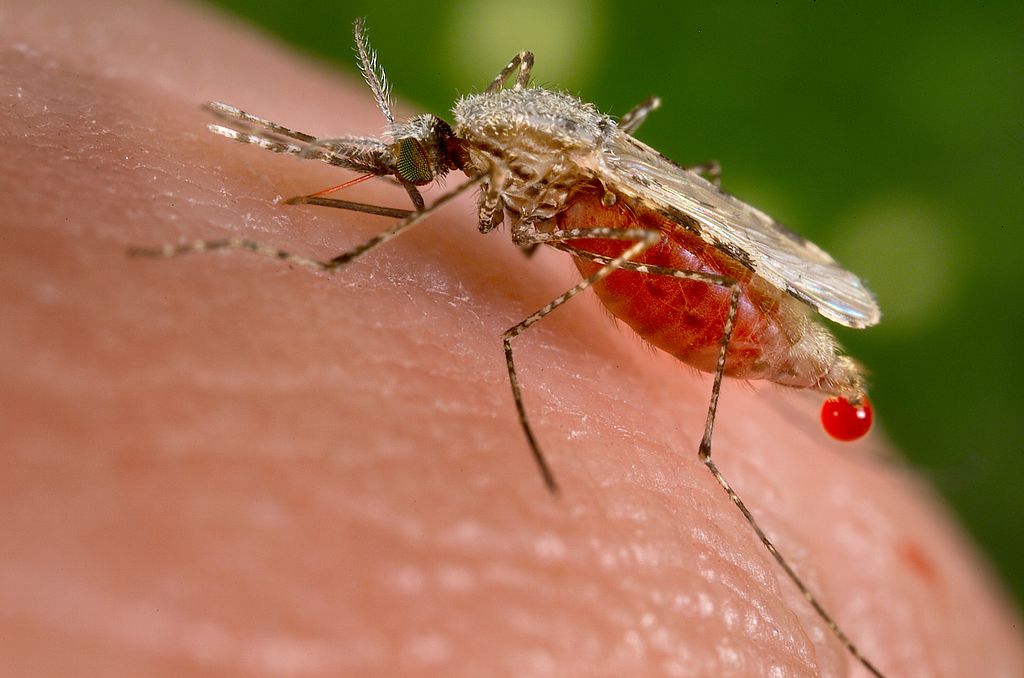 © Wikimedia.org/Jim Gathany, CC0
© Wikimedia.org/Jim Gathany, CC0
Moths are a paraphyletic group of insects that includes all members of the order Lepidoptera that are not butterflies, with moths making up the vast majority of the order. There are thought to be approximately 160,000 species of moth, many of which have yet to be described. Most species of moth are nocturnal, but there are also crepuscular and diurnal species. (Source: Wikipedia.org, CC BY-SA)
Ceratopogonidae is a family of flies commonly known as no-see-ums, or biting midges, generally 1–3 millimetres (1⁄16–1⁄8 in) in length. The family includes more than 5,000 species, distributed worldwide, apart from the Antarctic and the Arctic. Ceratopogonidae are holometabolous, meaning their development includes four life stages: egg, larva, pupa, and imago or adult. Most common species in warmer climates will take about two to six weeks to complete a life cycle. Both adult males and females feed on nectar. Most females also feed on the blood of vertebrates, including humans, to get protein for egg-laying. Their bites are painful, and can cause intensely itchy lesions. Their mouthparts are well-developed for cutting the skin of their hosts. Some species prey on other insects. (Source: Wikipedia.org, CC BY-SA)
Aglais io, the European peacock, more commonly known simply as the peacock butterfly, is a colourful butterfly, found in Europe and temperate Asia as far east as Japan. It was formerly classified as the only member of the genus Inachis (the name is derived from Greek mythology, meaning Io, the daughter of Inachus[citation needed]). It should not be confused or classified with the 'American peacocks' in the genus Anartia; while belonging to the same family as the European peacock, Nymphalidae, the American peacocks are not close relatives of the Eurasian species. The peacock butterfly is resident in much of its range, often wintering in buildings or trees. It therefore often appears quite early in spring. The peacock butterfly has figured in research in which the role of eyespots as an anti-predator mechanism has been investigated. The peacock is expanding its range and is not known to be threatened. (Source: Wikipedia.org, CC BY-SA)
The European peacock (Parcoblatta pensylvanica) or Pennsylvanian cockroach is a common species of cockroach in eastern and central North America. Males are dark brown; the sides of the thorax and the front half of the wings are margined with yellow. Adult males are fully winged, while females have conspicuous wing pads (actually short wings like that of the female oriental cockroach), which are functionless. Wings of the male are longer than its body, while wing pads of the female cover only one-third to two-thirds of the abdomen. The males fly swiftly but do not have the ability to sustain themselves in the air for long periods. (Source: Wikipedia.org, CC BY-SA)
Antheraea polyphemus, the Polyphemus moth, is a North American member of the family Saturniidae, the giant silk moths. It is a tan-colored moth, with an average wingspan of 15 cm (6 in). The most notable feature of the moth is its large, purplish eyespots on its two hindwings. The eyespots give it its name – from the Greek myth of the cyclops Polyphemus. The species was first described by Pieter Cramer in 1776. The species is widespread in continental North America, with local populations found throughout subarctic Canada and the United States. The caterpillar can eat 86,000 times its weight at emergence in a little less than two months. (Source: Wikipedia.org, CC BY-SA)
The Gerridae are a family of insects in the order Hemiptera, commonly known as water striders, water skeeters, water scooters, water bugs, pond skaters, water skippers, or water skimmers. Consistent with the classification of the Gerridae as true bugs (i.e., suborder Heteroptera), gerrids have mouthparts evolved for piercing and sucking, and distinguish themselves by having the unusual ability to walk on water, making them pleuston (surface-living) animals. They are anatomically built to transfer their weight to be able to run on top of the water's surface. As a result, one could likely find water striders present in any pond, river, or lake. Over 1,700 species of gerrids have been described, 10% of them being marine. (Source: Wikipedia.org, CC BY-SA)
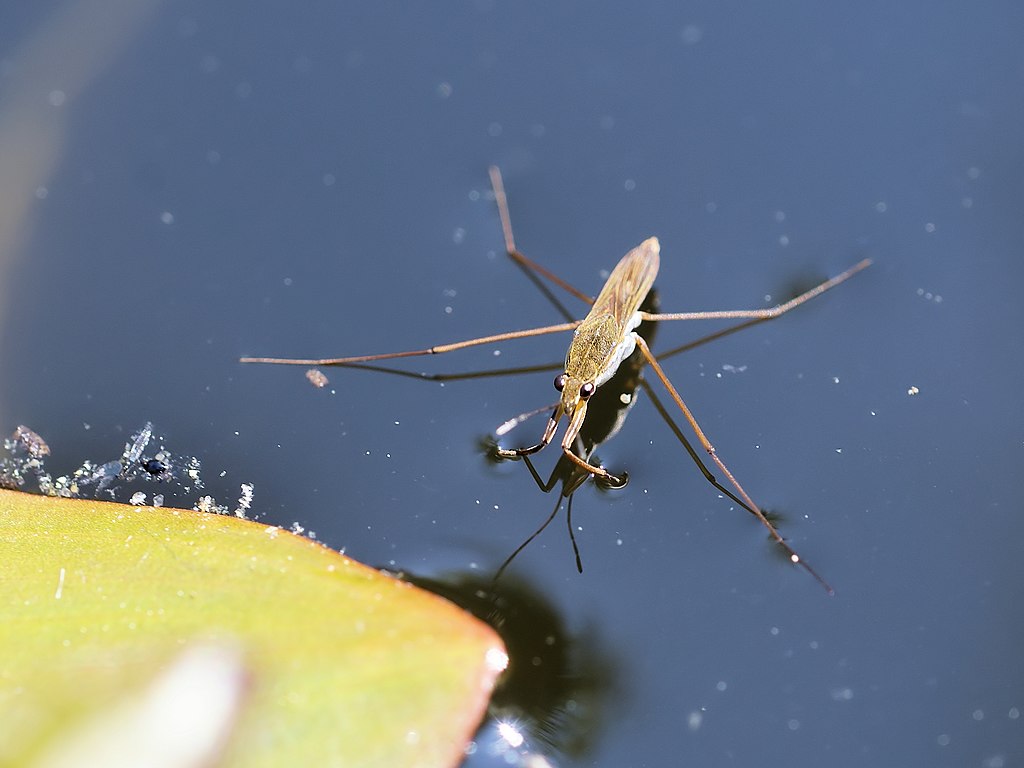 © Wikimedia.org/Hans Hillewaert, CC BY-SA
© Wikimedia.org/Hans Hillewaert, CC BY-SA
Mantises are an order (Mantodea) of insects that contains over 2,400 species in about 460 genera in 33 families. The largest family is the Mantidae ('mantids'). Mantises are distributed worldwide in temperate and tropical habitats. They have triangular heads with bulging eyes supported on flexible necks. Their elongated bodies may or may not have wings, but all Mantodea have forelegs that are greatly enlarged and adapted for catching and gripping prey; their upright posture, while remaining stationary with forearms folded, has led to the common name praying mantis. (Source: Wikipedia.org, CC BY-SA)
Megalopyge opercularis is a moth of the family Megalopygidae. It has numerous common names, including southern flannel moth for its adult form, and puss caterpillar, asp, Italian asp, Fire caterpillar, woolly slug, opossum bug, puss moth, tree asp, or asp caterpillar. The inch-long larva is generously coated in long, luxuriant hair-like setae, making it resemble a tiny Persian cat, the characteristic that presumably gave it the name 'puss'. It is variable in color, from downy grayish white to golden brown to dark charcoal gray. It often has a streak of bright orange running longitudinally. The 'fur' on early-stage larvae is sometimes extremely curly, giving them a cottony, puffed-up look. The body tapers to a tail that extends well beyond the body, unlike its relative M. crispata. The middle instar has a more disheveled, 'bad-hair-day' appearance, without a distinctive tail. The 'fur' of the larva contains venomous spines that cause extremely painful reactions in human skin upon contact. The adult moth is covered in long fur in colors ranging from dull orange to lemon yellow, with hairy legs and fuzzy black feet. (Source: Wikipedia.org, CC BY-SA)
The redback spider (Latrodectus hasselti), also known as the Australian black widow, is a species of highly venomous spider believed to originate in South Australia or adjacent Western Australian deserts, but now found throughout Australia, Southeast Asia and New Zealand, with colonies elsewhere outside Australia. It is a member of the cosmopolitan genus Latrodectus, the widow spiders. The adult female is easily recognised by her spherical black body with a prominent red stripe on the upper side of her abdomen and an hourglass-shaped red/orange streak on the underside. Females usually have a body length of about 10 millimetres (0.4 in), while the male is much smaller, being only 3–4 mm (0.12–0.16 in) long. (Source: Wikipedia.org, CC BY-SA)
Scorpions are predatory arachnids of the order Scorpiones. They have eight legs, and are easily recognized by a pair of grasping pincers and a narrow, segmented tail, often carried in a characteristic forward curve over the back and always ending with a stinger. The evolutionary history of scorpions goes back 435 million years. They mainly live in deserts but have adapted to a wide range of environmental conditions, and can be found on all continents except Antarctica. There are over 2,500 described species, with 22 extant (living) families recognized to date. Their taxonomy is being revised to account for 21st-century genomic studies. (Source: Wikipedia.org, CC BY-SA)
A snail is, in loose terms, a shelled gastropod. The name is most often applied to land snails, terrestrial pulmonate gastropod molluscs. However, the common name snail is also used for most of the members of the molluscan class Gastropoda that have a coiled shell that is large enough for the animal to retract completely into. When the word 'snail' is used in this most general sense, it includes not just land snails but also numerous species of sea snails and freshwater snails. Gastropods that naturally lack a shell, or have only an internal shell, are mostly called slugs, and land snails that have only a very small shell (that they cannot retract into) are often called semi-slugs. (Source: Wikipedia.org, CC BY-SA)
Spiders (order Araneae) are air-breathing arthropods that have eight legs, chelicerae with fangs generally able to inject venom, and spinnerets that extrude silk. They are the largest order of arachnids and rank seventh in total species diversity among all orders of organisms. Spiders are found worldwide on every continent except for Antarctica, and have become established in nearly every land habitat. As of August 2022, 50,356 spider species in 132 families have been recorded by taxonomists. However, there has been debate among scientists about how families should be classified, with over 20 different classifications proposed since 1900. (Source: Wikipedia.org, CC BY-SA)
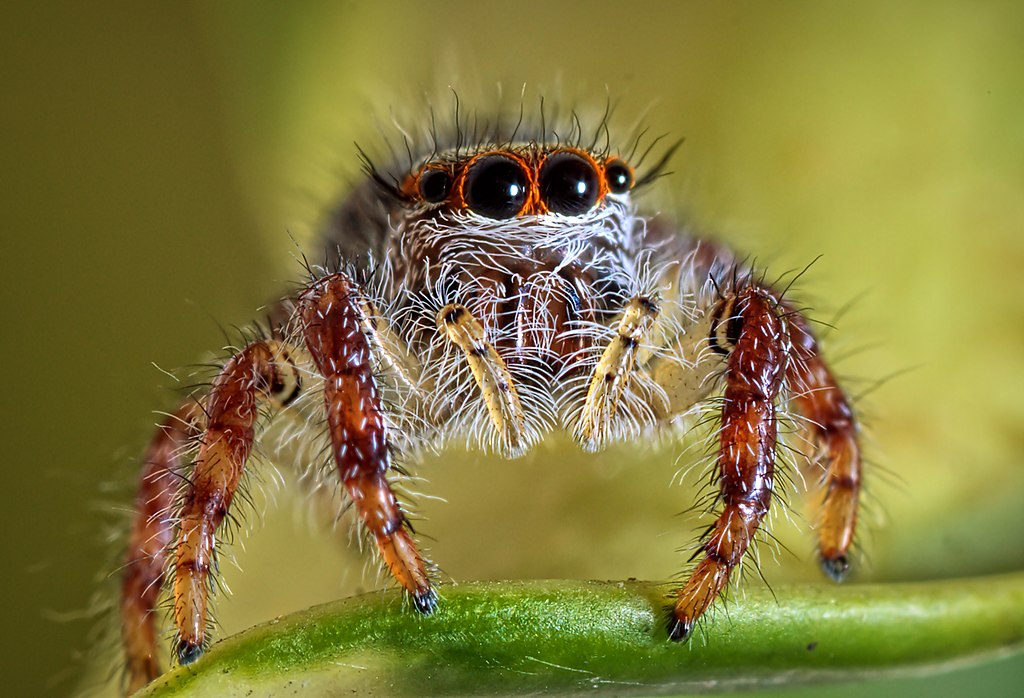 © Wikimedia.org/Ganjarmustika1904, CC BY-SA
© Wikimedia.org/Ganjarmustika1904, CC BY-SA
Wasps in the family Pompilidae are commonly called spider wasps, spider-hunting wasps, or pompilid wasps. The family is cosmopolitan, with some 5,000 species in six subfamilies. Nearly all species are solitary (with the exception of some group-nesting Ageniellini), and most capture and paralyze prey, though members of the subfamily Ceropalinae are kleptoparasites of other pompilids, or ectoparasitoids of living spiders. In South America, species may be referred to colloquially as marabunta or marimbondo, though these names can be generally applied to any very large stinging wasps. Furthermore, in some parts of Venezuela and Colombia, it is called matacaballos, or 'horse killers', while in Brazil some particular bigger and brighter species of the general marimbondo kind might be called fecha-goela/cerra-goela, or 'throat locker'. (Source: Wikipedia.org, CC BY-SA)
The spotted lanternfly (Lycorma delicatula) is a planthopper indigenous to parts of China. It has spread invasively to Japan, South Korea, and the United States. Its host plants include grapes, stone fruits, and Malus species, although its preferred host is Ailanthus altissima (Chinese sumac or tree of heaven). In its native habitat, L. delicatula populations are kept in check by parasitic wasps. The spotted lanternfly's life cycle is often centered on its preferred host Ailanthus altissima but L. delicatula can associate with more than 173 plants. Early life stages (instars) of the spotted lanternfly are characterized by spotted black and white nymphs that develop a red pigmentation and wings as they mature. Early life instars display a large host range that narrows with maturation. Adult spotted lanternflies display a black head, grey wings, and red hind wings. Adults do not display any specialized feeding associations with herbaceous plants but have been known to cause extensive damage to crops and ornamental plants. The piercing wounds caused by their mouthparts and the honeydew waste they excrete have been found to be significantly detrimental to the health of host plants. (Source: Wikipedia.org, CC BY-SA)
Epilachna borealis is a species of beetle that can commonly be found in the eastern United States. It is yellow with seven large black spots on each elytron and four small black spots on the pronotum. The species feeds on cucurbitaceous plants. Its common name is squash beetle. It is often mistaken for a ladybug or a cucumber beetle because of its similar appearance. The beetle lays a cluster of small yellow eggs on the leaf surfaces of cucurbitaceous plants. Both adult beetles and larvae feed on leaf tissue in between veins, and usually start by producing a semi-circle trench around their intended feeding area. Adult squash beetles can also be found feeding on the rind of pumpkins and squash later in the season. (Source: Wikipedia.org, CC BY-SA)
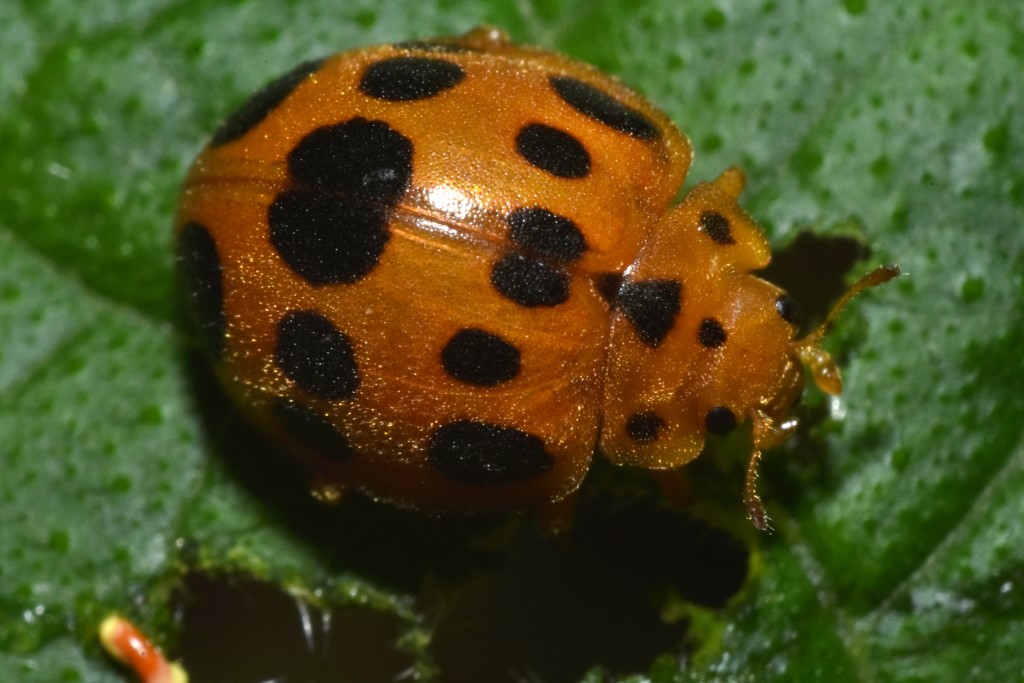 © Wikimedia.org/Mangodreads, CC BY-SA
© Wikimedia.org/Mangodreads, CC BY-SA
Stag beetles are a family of about 1,200 species of beetles in the family Lucanidae, currently classified in four subfamilies. Some species grow to over 12 centimetres (4+1⁄2 inches), but most to about 5 cm (2 in). Male stag beetles are known for their oversize mandibles used to wrestle each other for favoured mating sites in a way that parallels the way stags fight over females. Fights may also be over food, such as tree sap and decaying fruits. Despite their often fearsome appearance, they are not normally aggressive to humans. During a battle the main objective is to dislodge its opponent's tarsal claws with its mandible, thus disrupting their balance. Because its mandibles are capable of exceeding its own body size, stag beetles are generally inefficient runners, and typically fly from one location to another. Female stag beetles are usually smaller than the males, with smaller mandibles that are much more powerful than the males'. As larvae, females are distinguished by their cream-coloured, fat ovaries visible through the skin around two-thirds of the way down their back. (Source: Wikipedia.org, CC BY-SA)
The Phasmatodea (also known as Phasmida, Phasmatoptera or Spectra) are an order of insects whose members are variously known as stick insects, stick-bugs, walking sticks, stick animals, or bug sticks. They are also occasionally referred to as Devil's darning needles, although this name is shared by both dragonflies and crane flies. They can be generally referred to as phasmatodeans, phasmids, or ghost insects, with phasmids in the family Phylliidae called leaf insects, leaf-bugs, walking leaves, or bug leaves. The group's name is derived from the Ancient Greek φάσμα phasma, meaning an apparition or phantom, referring to their resemblance to vegetation while in fact being animals. Their natural camouflage makes them difficult for predators to detect; still, many species have one of several secondary lines of defense in the form of startle displays, spines or toxic secretions. Stick insects from the genera Phryganistria, Ctenomorpha, and Phobaeticus include the world's longest insects. (Source: Wikipedia.org, CC BY-SA)
A tarantula hawk is a spider wasp (Pompilidae) that preys on tarantulas. Tarantula hawks belong to any of the many species in the genera Pepsis and Hemipepsis. They are one of the largest parasitoid wasps, using their sting to paralyze their prey before dragging it to a brood nest as living food; a single egg is laid on the prey, hatching to a larva which eats the still-living prey. They are found on all continents other than Antarctica. Common species are up to 5 centimetres (2 in) long, making them among the largest of wasps, and have blue-black bodies and bright, rust-colored wings (other species have black wings with blue highlights). The vivid coloration found on their bodies, and especially wings, is an aposematism, advertising to potential predators the wasps' ability to deliver a powerful sting. Their long legs have hooked claws for grappling with their victims. The stinger of a female Pepsis grossa can be up to 7 mm (9⁄32 in) long, and the powerful sting is considered one of the most painful insect stings in the world. (Source: Wikipedia.org, CC BY-SA)
Termites are small insects that live in colonies and have distinct castes (eusocial) and feed on wood or other dead plant matter. Termites comprise the infraorder Isoptera, or alternatively the epifamily Termitoidae, within the order Blattodea (along with cockroaches). Termites were once classified in a separate order from cockroaches, but recent phylogenetic studies indicate that they evolved from cockroaches, as they are deeply nested within the group, and the sister group to wood eating cockroaches of the genus Cryptocercus. Previous estimates suggested the divergence took place during the Jurassic or Triassic. More recent estimates suggest that they have an origin during the Late Jurassic, with the first fossil records in the Early Cretaceous. About 3,106 species are currently described, with a few hundred more left to be described. Although these insects are often called 'white ants', they are not ants, and are not closely related to ants. (Source: Wikipedia.org, CC BY-SA)
Tiger beetles are a family of beetles, Cicindelidae, known for their aggressive predatory habits and running speed. The fastest known species of tiger beetle, Rivacindela hudsoni, can run at a speed of 9 km/h (5.6 mph; 2.5 m/s), or about 125 body lengths per second. As of 2005, about 2,600 species and subspecies were known, with the richest diversity in the Oriental (Indo-Malayan) region, followed by the Neotropics. While historically treated as a subfamily of ground beetles (Carabidae) under the name Cicindelinae, several studies since 2020 indicated that they should be treated as a family, the Cicindelidae, which are a sister group to Carabidae within the Adephaga. (Source: Wikipedia.org, CC BY-SA)
The Arctiinae (formerly called the family Arctiidae) are a large and diverse subfamily of moths with around 11,000 species found all over the world, including 6,000 neotropical species. This subfamily includes the groups commonly known as tiger moths (or tigers), which usually have bright colours, footmen, which are usually much drabber, lichen moths, and wasp moths. Many species have 'hairy' caterpillars that are popularly known as woolly bears or woolly worms. The scientific name Arctiinae refers to this hairiness (Gk. αρκτος = a bear). Some species within the Arctiinae have the word 'tussock'' in their common names because they have been misidentified as members of the Lymantriinae subfamily based on the characteristics of the larvae. (Source: Wikipedia.org, CC BY-SA)
Tsetse (/ˈsiːtsi/ SEET-see, US: /ˈtsiːtsi/ TSEET-see or UK: /ˈtsɛtsə/ TSET-sə), sometimes spelled tzetze and also known as tik-tik flies, are large biting flies that inhabit much of tropical Africa. Tsetse flies include all the species in the genus Glossina, which are placed in their own family, Glossinidae. The tsetse are obligate parasites that live by feeding on the blood of vertebrate animals. Tsetse have been extensively studied because of their role in transmitting disease. They have a prominent economic impact in sub-Saharan Africa as the biological vectors of trypanosomes, which cause human sleeping sickness and animal trypanosomiasis. Tsetse are multivoltine and long-lived, typically producing about four broods per year, and up to 31 broods over their lifespans. (Source: Wikipedia.org, CC BY-SA)
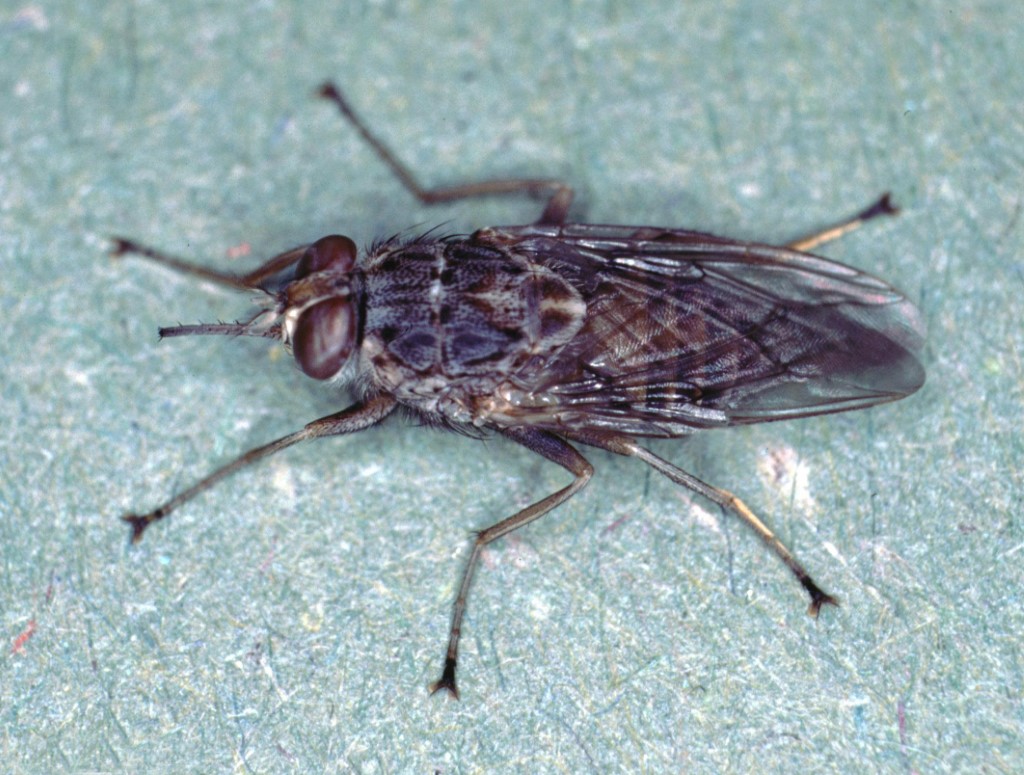 © Wikimedia.org/Alan R Walker, CC BY-SA
© Wikimedia.org/Alan R Walker, CC BY-SA
A wasp is any insect of the narrow-waisted suborder Apocrita of the order Hymenoptera which is neither a bee nor an ant; this excludes the broad-waisted sawflies (Symphyta), which look somewhat like wasps, but are in a separate suborder. The wasps do not constitute a clade, a complete natural group with a single ancestor, as bees and ants are deeply nested within the wasps, having evolved from wasp ancestors. Wasps that are members of the clade Aculeata can sting their prey. The most commonly known wasps, such as yellowjackets and hornets, are in the family Vespidae and are eusocial, living together in a nest with an egg-laying queen and non-reproducing workers. Eusociality is favoured by the unusual haplodiploid system of sex determination in Hymenoptera, as it makes sisters exceptionally closely related to each other. However, the majority of wasp species are solitary, with each adult female living and breeding independently. (Source: Wikipedia.org, CC BY-SA)
Pieris rapae is a small- to medium-sized butterfly species of the whites-and-yellows family Pieridae. It is known in Europe as the small white, in North America as the cabbage white or cabbage butterfly, on several continents as the small cabbage white, and in New Zealand as the white butterfly. The butterfly is recognizable by its white color with small black dots on its wings, and it can be distinguished from P. brassicae by its larger size and the black band at the tip of its forewings. (Source: Wikipedia.org, CC BY-SA)
Wolf spiders are members of the family Lycosidae (from Ancient Greek λύκος (lúkos) 'wolf'). They are robust and agile hunters with excellent eyesight. They live mostly in solitude, hunt alone, and do not spin webs. Some are opportunistic hunters, pouncing upon prey as they find it or chasing it over short distances; others wait for passing prey in or near the mouth of a burrow. Wolf spiders resemble nursery web spiders (family Pisauridae), but wolf spiders carry their egg sacs by attaching them to their spinnerets, while the Pisauridae carry their egg sacs with their chelicerae and pedipalps. Two of the wolf spider's eight eyes are large and prominent; this distinguishes them from nursery web spiders, whose eyes are all of roughly equal size. This can also help distinguish them from the similar-looking grass spiders. (Source: Wikipedia.org, CC BY-SA)
 © Wikimedia.org/Raphaël Poupon, CC BY-SA
© Wikimedia.org/Raphaël Poupon, CC BY-SA

Time for recess! Post a comment, ask a question or write a review. Feel free to let us know what you think!
This app does not work for italian patente in French language. A bit frustrating to use
Tres intéressant , ça aide énormément pour bien analyser les questions et les réponses. Merci bcp
Carte du Permis de Conduire Classic AB Routiére Gillera Runner Dynamic Américaine
C'est un peu dificir d'etudies de règles de lå circulation sur internet, ici en Sweden pas de livres en france alors comment nous devon faire?
j'ai eu 1/ fin de l'autoroute 2/ fin de l'autoroute 3/ x 4/ y je prends la réponse 1, on me dit que j'ai faux et que j'aurais dû choisir 2... "lumière tamisée" pour feux de croisement, traduction vraiment approximative... Bon en gros c'est juste un quizz panneaux, ça me permet de découvrir un peu, mais je reste sceptique sur la qualité du tout. Je remercie l'effort.
Je viens de passer aujourd'hui le vrai test au DLT, je vous assure que ça n'a pas grand chose à voir...il y a des questions sur la législation, l'entretien, de plus, on demande dans une série de réponse laquelle est correcte, or, parfois, il y a plusieurs réponses correctes !! On fait quoi...très déçu par l'esprit de ce contrôle